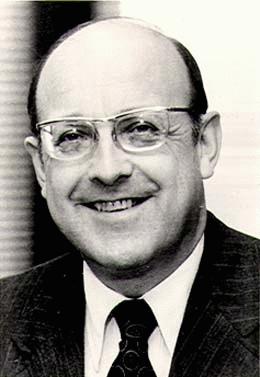On November 1, 1975, William Arthur Bulley (b. 1925) becomes the Director of Highways for the state Highway Department. When in September 1977 the Legislature creates the Washington State Department of Transportation (WSDOT) and the State Transportation Commission, Bulley will be re-appointed to the top position, now renamed the "Secretary of Transportation."
William Bulley, Director of Highways (1975-1977), and then the first Secretary of Transportation (1977-1981), was born in Spokane on May 24, 1925. Immediately after graduation from West Valley High in 1943, he enlisted and for the remainder of World War II served in Europe in the 103rd Division of the Seventh Army. Upon his return, he entered the University of Washington, and in 1951 graduated with a degree in Civil Engineering and graduate studies in Industrial Engineering.
A Highway Engineer
After graduation, he began working for the Department of Highways as a bridge engineer. In 1956, as structural engineer and head of the bridge design office, he took charge of all Seattle freeway bridges and of the Lake Washington Ship Canal Bridge. In 1962 he was named Assistant Construction Engineer for District 7 (Seattle), and in this capacity was responsible for the construction of a portion of Interstate 5 and Interstate 405. In 1965 he was named district construction engineer, and in 1966 he became the Highway Engineer for District 4, headquartered in Vancouver, Washington.
In 1968, he became the department's assistant highway director for management services, responsible for finance, budgeting, and other administrative activities. He was also the legislative liaison in Olympia. In September 1969, he was named deputy director, filling the position of George H. Andrews (1969-1975) when Andrews became Director of Highways to replace Charles G. Prahl (1963-1969).
The Highway Commission named Bulley State Highways Director in November 1975, shortly before the Legislature created the Washington State Department of Transportation (WSDOT) to take over the Department of Highways and other related commissions and authorities on September 21, 1977. The State Transportation Commission replaced the Highway Commission, and Bulley was named the new department's first secretary of transportation.
On Bulley's Watch
Bulley served as Secretary of Transportation through the following difficulties and accomplishments:
- a court injunction halting I-90 work through the Snoqualmie Pass (1976);
- the Commission memorandum of understanding with Seattle, Mercer Island, Bellevue, and King County on Interstate 90's design (December 21, 1976);
- the first public vanpooling (1979);
- the sinking of the west half of the Hood Canal Bridge on February 13, 1979;
- the lifting of the federal injunction that had halted Interstate 90's construction between I-5 and I-405 (August 24, 1979);
- the eruption of Mt. Saint Helens on May 18, 1980, which caused the destruction of more than 30 miles of SR 504 and necessitated the closing of 1,000 miles of state highways including stretches of I-5, and I-90.
In Bulley's words, he had to resolve some "very expensive troubles."
Moving On
In November 1979, Bulley announced his plan to retire on February 28, 1980, but due to the Transportation Commission's preoccupation with problems with newly constructed ferries as well as labor issues in the Washington State Ferries system, he agreed to stay on until a suitable replacement could be found. Chair of the Transportation Commission Julia Butler Hansen said, "We are sorry to lose him because it has been with his guiding hand that the department has become one of the most respected agencies in Washington state government" (Burt).
Duane Berentson replaced Bulley as secretary of transportation on May 21, 1981. Bulley subsequently became senior vice-president for H. W. Lochner of Chicago in the firm's Bellevue headquarters. Morrison-Knudsen Company, the company WDSOT hired to manage construction of I-90, later chose H. W. Lochner as a partner in that $4.3 million contract. In 1999, Bulley "pretty well retired" from H. W. Lochner, although he remains with the firm as an advisor to the chairman of the company.

